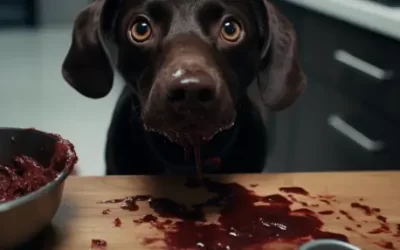As dog lovers and responsible pet owners, it’s only natural to want the best for our furry companions. If you’ve found yourself pondering the question “Can Dogs Eat Pasta?” in the vast sea of information on pet nutrition, you’re not alone.
The internet is flooded with various perspectives, and it can be perplexing to discern what’s genuinely beneficial for your canine friend.
The search for reliable and comprehensive insights into whether pasta is a suitable addition to your dog’s diet reflects a genuine concern for their well-being, and it’s this concern that we share and address in this article.
As someone with years of experience in the veterinary field and a deep understanding of pet nutrition, I recognize the importance of providing trustworthy guidance to fellow pet enthusiasts.
The question of whether dogs can safely consume pasta is not a simple yes or no, and my aim is to share insights that go beyond the surface, offering a well-informed perspective that considers various factors such as pasta types, additives, and serving sizes.
Your quest for answers is acknowledged, and I’m here to offer clarity based on a wealth of experience in the field.
This article is crafted to address the concerns and curiosities of dog owners like yourself. From exploring the nutritional aspects of pasta and its potential benefits to highlighting risks and concerns associated with specific ingredients, we delve into every angle of the topic.
Read on to discover a comprehensive guide that combines veterinary expertise with a well-crafted information to ensuring that you’re equipped with the knowledge needed to make informed decisions about your dog’s diet.
- Understanding a Dog’s Diet
- Types of Pasta and Their Suitability for Dogs
- Benefits of Feeding Pasta to Dogs
- Risks and Concerns From Feeding Pasta
- Preparing Pasta for Dogs
- Expert Opinions and Veterinary Perspectives
- Safe Alternatives to Pasta for Dogs
- Final Thoughts: Can Dogs Eat Pasta?
- Frequently Asked Questions on Feeding Dogs Pasta
- What Pasta Should Dogs Eat?
Understanding a Dog’s Diet

As we delve into the intricacies of a dog’s diet, it becomes evident that our furry companions have unique nutritional needs. Ensuring their well-being involves a careful exploration of these requirements and a thoughtful comparison to our own diets.
An Exploration of a Dog’s Nutritional Needs
Dogs, much like humans, thrive on a balanced and nutritious diet. Essential components include proteins for muscle development, fats for energy and a lustrous coat, carbohydrates for readily available energy, and key vitamins and minerals for overall health.
Unlike humans, dogs don’t have a strict dietary requirement for carbohydrates, and their specific needs vary across breeds and life stages. Understanding these nuances is crucial for tailoring nutrition plans that support their growth and well-being.
Comparison Between Canine and Human Dietary Requirements
While there are similarities in dietary requirements, dogs and humans have distinct differences. Dogs, being omnivores with a carnivorous bias, need a diet rich in animal-derived proteins. Their shorter digestive tract emphasizes the importance of easily digestible, nutrient-dense foods.
Unlike humans, dogs are sensitive to certain ingredients, and many human foods can be toxic to them. Recognizing these distinctions guides us in providing meals that align with their nutritional needs, promoting the health and longevity of our cherished canine companions.
Types of Pasta and Their Suitability for Dogs

Delving into the realm of pasta for our canine friends requires a nuanced understanding of the various types and their appropriateness in a dog’s diet. From plain to whole wheat and gluten-free options, the selection of pasta plays a vital role in maintaining our dogs’ nutritional balance.
Various Pasta Types (Plain, Whole Wheat, Gluten-Free)
In evaluating pasta choices for dogs, the type holds nutritional significance. Plain pasta, while a source of carbohydrates, may lack the additional nutrients found in whole wheat or multigrain alternatives.
Whole wheat pasta, with its heightened fiber content and nutritional richness, stands out as a more wholesome option for our canine companions.
Gluten-free variations, utilizing rice or legume flours, cater to dogs with sensitivities or allergies. Striking the right balance and consulting with a veterinarian ensure that pasta, when included, complements rather than replaces a dog’s primary nutrition.
Discussion on the Impact of Additives like Sauces and Seasonings
Despite pasta being a potentially suitable addition to a dog’s diet, attention must be given to additives such as sauces and seasonings.
Dogs, with their sensitive palates, are susceptible to ingredients like garlic or onion commonly used in human sauces.
Opting for plain, unseasoned pasta mitigates risks and allows dogs to indulge safely. For those seeking a hint of flavor, minimalistic alternatives like plain tomato sauce or dog-safe herbs can be considered.
In this delicate balance, we can ensure that sharing pasta with our canine companions is both a pleasurable and safe experience.
Benefits of Feeding Pasta to Dogs

As we navigate the culinary landscape for our canine companions, it’s essential to explore the potential benefits that pasta can offer in a dog’s diet.
From nutritional components to the importance of moderation, understanding these aspects ensures a balanced approach to including pasta in our furry friends’ meals.
Nutritional Components in Pasta That May Benefit Dogs
Pasta, in its various forms, can contribute beneficial nutritional components to a dog’s diet. The primary advantage lies in its carbohydrate content, which provides a source of energy that supports the active lifestyle of many dogs.
Additionally, pasta contains essential nutrients such as vitamins and minerals, contributing to overall health.
Whole wheat or multigrain options further enhance the nutritional profile, offering additional fiber and micronutrients. While not a staple in a dog’s diet, the occasional inclusion of pasta, coupled with a well-rounded canine nutrition plan, can provide valuable supplementary elements.
Moderation and Balance in Including Pasta in a Dog’s Diet
While pasta can offer nutritional benefits, the key lies in moderation and balance. Dogs, being primarily carnivores, require a diet rich in animal-derived proteins. Pasta should complement, not substitute, their primary nutrition.
Including pasta in moderation helps prevent overconsumption of carbohydrates and ensures a diverse diet that meets their specific needs.
Portion control is crucial, considering factors such as the dog’s size, breed, and overall health. Consulting with a veterinarian aids in determining the appropriate amount and frequency of pasta inclusion, aligning with the individual needs of each dog.
Risks and Concerns From Feeding Pasta

While contemplating whether to include pasta in our dogs’ diets, it is imperative to acknowledge the potential risks and concerns associated with this popular human food. From gluten intolerance to the hazards of excessive salt and spices, understanding these factors is crucial for responsible pet ownership.
Potential Issues (Gluten Intolerance)
One notable concern when considering pasta for dogs is the possibility of gluten intolerance. Gluten, a protein found in wheat and some other grains, can lead to digestive issues in dogs with sensitivities.
While gluten-free pasta options are available, it’s essential to recognize the signs of intolerance, such as gastrointestinal upset, skin issues, or changes in behavior.
Monitoring a dog’s response to pasta consumption allows pet owners to tailor their choices to the individual needs of their furry companions, ensuring a comfortable and healthy dietary experience.
The Risk of Excessive Salt and Spices
Another critical aspect to consider is the risk associated with excessive salt and spices often present in pasta dishes. Dogs, being more sensitive to sodium, can experience adverse effects from high salt intake, including increased thirst, urination, and, in severe cases, sodium ion poisoning.
Additionally, certain spices commonly used in human recipes, such as garlic or onion, can be toxic to dogs. Opting for plain, minimally seasoned pasta reduces these risks, allowing dogs to enjoy this treat safely.
Maintaining a vigilant eye on ingredient lists and practicing moderation ensures that the potential risks associated with salt and spices are mitigated.
Preparing Pasta for Dogs

As we embark on the culinary exploration of sharing pasta with our canine companions, understanding the art of preparation is paramount.
From safe cooking methods to tailoring serving sizes based on individual characteristics, the thoughtful preparation of pasta for dogs ensures a delightful and health-conscious dining experience.
Safe Cooking Methods and Avoiding Harmful Ingredients
When preparing pasta for dogs, it’s essential to adhere to safe cooking methods and avoid potentially harmful ingredients. Opting for plain, unseasoned pasta is a foundational step, steering clear of spices like garlic or onion, which can be detrimental to a dog’s health.
Boiling pasta in plain water without added salts or oils ensures a simple and safe base. Additionally, refraining from using excessive butter or rich sauces is advised, as these can contribute to unnecessary calories and may not align with a dog’s dietary requirements.
The goal is to create a plain and palatable pasta dish that complements a dog’s nutritional needs without introducing elements that could pose risks to their well-being.
Appropriate Serving Sizes Based on Dog Size and Breed
Determining appropriate serving sizes is a crucial consideration when incorporating pasta into a dog’s diet. Portion control is key, and the serving size should be tailored to the dog’s size, breed, and individual health requirements.
Larger breeds may tolerate larger portions, but moderation is universally important. The addition of pasta to a dog’s diet should complement their primary nutrition rather than dominate it.
Consulting with a veterinarian aids in establishing suitable serving sizes, taking into account the dog’s activity level, age, and any health conditions. This personalized approach ensures that the pasta serves as a delightful addition to their meals without compromising their overall well-being.
Expert Opinions and Veterinary Perspectives

In our pursuit of providing the best possible care for our canine companions, seeking insights from veterinary professionals becomes invaluable. When it comes to including pasta in a dog’s diet, expert opinions and veterinary perspectives offer a well-informed guide to navigate this culinary decision.
Insights from Veterinarians on Pasta in a Dog’s Diet
Veterinarians, with their extensive knowledge of animal nutrition and health, provide valuable insights into the role of pasta in a dog’s diet.
While pasta itself can be a source of carbohydrates and certain nutrients, their guidance often emphasizes the importance of moderation and choosing pasta types wisely.
Veterinarians may recommend plain pasta without additives, taking into account a dog’s specific dietary needs and potential sensitivities.
Their nuanced perspectives guide pet owners in making informed decisions that align with their dogs’ well-being, ensuring a balanced approach to incorporating pasta into their meals.
Any Studies or Research Supporting or Cautioning Against Feeding Pasta to Dogs
Scientific studies and research contribute additional layers of understanding when it comes to feeding pasta to dogs. While there may be limited specific studies on pasta, broader research on canine nutrition sheds light on the potential benefits and risks associated with including human foods in a dog’s diet.
Some studies may caution against certain ingredients found in pasta, such as excessive salt or toxic seasonings, while others may highlight the positive aspects of incorporating plain pasta in moderation.
Veterinary-endorsed research plays a pivotal role in shaping recommendations and guidelines for responsible feeding practices, ensuring that the decisions we make for our dogs are backed by scientific evidence.
Safe Alternatives to Pasta for Dogs

While contemplating the inclusion of pasta in a dog’s diet, it’s essential to explore a spectrum of alternatives that cater to their nutritional needs.
Diversifying their diet not only enhances palatability but also ensures a comprehensive array of essential nutrients, fostering optimal health and well-being for our beloved canine companions.
Exploring Other Dog-Friendly Food Options
Dogs, much like humans, benefit from a varied diet that goes beyond a single food item. Incorporating dog-friendly alternatives to pasta broadens their culinary experiences.
Lean meats, such as chicken or turkey, serve as excellent sources of protein, supporting muscle health. Fish, rich in omega-3 fatty acids, contributes to a shiny coat and promotes heart health.
Vegetables like carrots and green beans offer vitamins and fiber, while fruits like blueberries and apples provide antioxidants. These alternatives not only cater to a dog’s nutritional requirements but also introduce diverse flavors and textures, making mealtime an enjoyable experience.
Maintaining a Diverse and Balanced Diet for Dogs
Maintaining a diverse and balanced diet is pivotal in promoting overall health for dogs. Each food item contributes unique nutrients, and a variety of options ensures that dogs receive a well-rounded spectrum of vitamins and minerals.
Rotation feeding, where different foods are introduced in a planned manner, helps prevent nutritional imbalances and allergies. While pasta can be a part of their diet, integrating a range of dog-friendly alternatives ensures a holistic approach to nutrition.
Consulting with a veterinarian aids in creating a customized diet plan tailored to the specific needs and preferences of individual dogs, fostering a lifestyle that prioritizes both nutritional excellence and gustatory delight.
Final Thoughts: Can Dogs Eat Pasta?

Dogs can eat pasta in moderation. Plain, cooked pasta without any additives or harmful ingredients can be a safe occasional treat for dogs.
Pasta can provide a source of carbohydrates and certain nutrients, but it should not replace their primary diet, which should consist of well-balanced and nutritionally complete dog food.
It’s crucial to avoid serving pasta with sauces or seasonings, particularly ingredients like garlic or onion, which can be toxic to dogs.
Additionally, serving sizes should be appropriate for the dog’s size, breed, and individual health conditions. As with any addition to a dog’s diet, consulting with a veterinarian is advisable to ensure that it aligns with the dog’s specific nutritional needs and overall well-being.
As we conclude our exploration into the question “Can Dogs Eat Pasta?” it is imperative to distill the wealth of information into actionable insights that resonate with responsible pet ownership.
Navigating the realms of nutrition, benefits, risks, and alternatives, we arrive at a nuanced perspective that balances the joys of sharing our meals with our canine companions and the need for ensuring their optimal health.
Summarizing Key Points
Throughout this journey, we’ve delved into the intricacies of a dog’s diet, understanding the nutritional components in pasta that may benefit them, the potential risks associated with gluten intolerance, excessive salt, and spices, and the art of preparing pasta with a mindful eye on ingredients and serving sizes.
Expert opinions and veterinary perspectives have lent their weight to our decision-making process, emphasizing the importance of moderation and choosing wisely.
Alternatives to pasta have been explored, underlining the significance of a diverse and balanced diet for our furry friends.
Final Recommendation on Feeding Dogs Pasta in Moderation
In encapsulating our findings, the answer to whether dogs can eat pasta lies in moderation and thoughtful consideration. While pasta can contribute valuable nutrients, the choice of type, preparation, and serving size is crucial.
Plain, unseasoned pasta, cooked with care and offered in appropriate portions, can be a delightful addition to a dog’s diet.
However, responsible pet ownership requires an awareness of potential risks and the exploration of diverse alternatives to maintain a balanced and nutritious culinary experience for our dogs.
With guidance from veterinary professionals, a personalized approach to each dog’s unique needs ensures that the joys of sharing pasta with our furry friends align harmoniously with their health and well-being.
Frequently Asked Questions on Feeding Dogs Pasta
Can dogs eat plain pasta?
Is whole wheat pasta safe for dogs?
Can dogs eat pasta with sauces or seasonings?
Are there risks associated with dogs eating pasta?
How much pasta can I give to my dog?
What Pasta Should Dogs Eat?
Can Dogs Eat Alfredo Pasta?
Can Dogs Eat Red Bean Pasta?
Can Dogs Eat Chicken Alfredo Pasta?
Can Dogs Eat Dried Pasta?
Can Dogs Eat Guava Paste?







